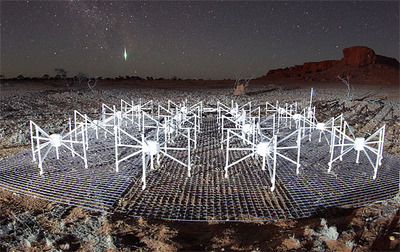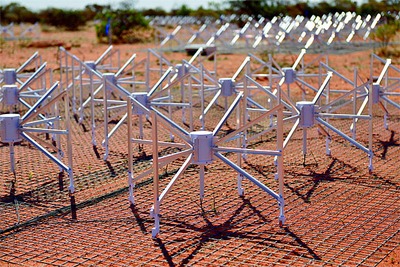Australian telescope to reveal early universe
Solar storms, space junk and the formation of the universe are about to be seen in an entirely new way with the recent start of operations of the $51 million Murchison Widefield Array (MWA) radio telescope.
The first of three international precursors facilities to the $2 billion Square Kilometre Array (SKA) telescope, the MWA is located in a remote pocket of outback Western Australia. It is the product of an international project led by Curtin University.
Using bleeding-edge technology, the MWA will become an eye on the sky, acting as an early warning system that will potentially help to save billions of dollars as it steps up observations of the Sun to detect and monitor massive solar storms. It will also investigate a unique concept that will see stray FM radio signals used to track dangerous space debris.

The MWA will also give scientists an unprecedented view into the first billion years of the universe, enabling them to look far into the past by studying radio waves that are more than 13 billion years old. This major field of study has the potential to revolutionise the field of astrophysics.
“This collaboration between some of astronomy’s greatest minds has resulted in the creation of a groundbreaking facility,” Director of the MWA and Professor of Radio Astronomy at Curtin University Steven Tingay said.
“Right now we are standing at the frontier of astronomical science. Each of these programs has the potential to change our understanding about the universe.”
Nine major projects
The development and commissioning of the MWA, the most powerful low-frequency radio telescope in the Southern Hemisphere, is the outcome of nearly nine years’ work by an international consortium of 13 institutions across four countries (Australia, USA, India and New Zealand).
The detailed observations will be used by scientists to hunt for explosive and variable objects in the Milky Way such as black holes and exploding stars, as well as to make the most comprehensive survey of the Southern Hemisphere sky at low radio frequencies.
From mid July, regular data will be captured through the entirely static telescope, which spans a three-kilometre area at the CSIRO’s Murchison Radio-astronomy Observatory, future home to the SKA.
The data will be processed 800 kilometres away at the $80 million Pawsey High Performance Computing Centre for SKA Science, in Perth, carried there on a link provided by the NBN and enabled by AARNet. The MWA will be the Pawsey Centre’s first large-scale customer.
Nine major research programs were announced at the launch, with more than 700 scientists across four continents awaiting the information the telescope has now begun to capture.

“Given the quality of the data obtained during the commissioning process and the vast areas of study that will be investigated, we are expecting to see preliminary results in as little as three months’ time,” Professor Tingay said.
“This is an exciting prospect for anyone who’s ever looked up at the sky and wondered how the universe came to be.
“The MWA has and will continue to lift the bar even higher for the SKA.”
Forerunner to the SKA
Under Professor Tingay and fellow colleague Professor Peter Hall’s guidance, Curtin University has been awarded a $5 million grant by the Australian Government to participate in the SKA pre-construction program over the next three years, with the MWA’s unique insight being used to develop a low frequency radio telescope that is expected to be 50 times more sensitive.
The MWA has been supported by both state and federal government funding, with the majority of federal funding being administered by Astronomy Australia Limited.
The MWA project says it recognises the Wadjarri Yamatji people as the traditional owners of the site on which the MWA is built and thanks the Wadjarri Yamatji people for their support, as well as that of Astronomy Australia Limited.
The MWA launch event took place simultaneously at the Astronomical Society of Australia’s annual scientific meeting hosted at Monash University Melbourne and the Murchison Radio-astronomy Observatory in the Murchison shire, Western Australia.
For more information on the Murchison Widefield Array, visit www.mwatelescope.org.
2025–26 Thought Leaders: Tim Karamitos
Tim Karamitos from Ericsson discusses the connectivity requirements of emergency services and...
2025–26 Thought Leaders: Ruth Tovo
Comms Connect panellist Ruth Tovo, from the South Australian SES, discusses the technical...
ARCIA update: celebrating excellence in our industry
The ARCIA Annual Gala Dinner and Excellence Awards took place during the same week as Comms...



